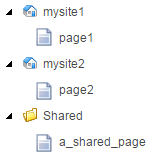Use the Sitecore LinkManager to resolve URIs
Use the Sitecore LinkManager to resolve URIs
|
|
Legacy feature
The Coveo Hive Framework is now in maintenance mode and is no longer recommended for new implementations. To build new search experiences, use one of Coveo’s more modern, lightweight, and responsive libraries. To get started, see the Build search article. |
This page explains how to use the Sitecore LinkManager to resolve search result clickable URIs on a Coveo Hive search page.
What’s the LinkManager
The LinkManager is a module of Sitecore used to resolve clickable URIs. For example, you may only want to display relative URIs, or add the current item language to its URI. The LinkManager is particularly useful in a multi-site configuration, where an item can be accessed via different URIs that seem completely unrelated to each other.
For example, if you have the following structure under the Content node:

And if your Sites node in your <SITECORE_INSTANCE_ROOT>\App_Config\Sitecore.config file looks like this:
<site name="mysite1" hostName="www.mysite1.ca" virtualFolder="/" physicalFolder="/" rootPath="/sitecore/content" startItem="/mysite1" language="en" database="web" domain="extranet" enableWebEdit="true" />
<site name="mysite2" hostName="www.mysite2.ca" virtualFolder="/" physicalFolder="/" rootPath="/sitecore/content" startItem="/mysite2" language="en" database="web" domain="extranet" enableWebEdit="true" />Given the above configuration, the required IIS bindings, and a properly configured hosts file, it’s possible to access the page1 item via the URI www.mysite1.ca/page1 and the page2 item via the URI www.mysite2.ca/page2.
This would also allow you to access the page2 item with the following URI: www.mysite1.ca/mysite2/page2.
The ResolveResultClickableUriProcessor
On a Coveo Hive search page, the Sitecore LinkManager configures your clickable URIs.
This configuration comes from the execution of the ResolveResultClickableUriProcessor processor, which you can find in your <SITECORE_INSTANCE_ROOT>\App_Config\Modules\Coveo\Coveo.SearchProvider.Rest.config file.
|
|
Don’t modify the |
<coveoProcessParsedRestResponse>
<processor type="Coveo.SearchProvider.Rest.Processors.CoveoProcessParsedRestResponse.ResolveResultClickableUriProcessor, Coveo.SearchProvider.Rest" />
</coveoProcessParsedRestResponse>|
|
Note
This processor uses the following fields: |
Configuring the LinkManager
-
Configure the
<sites>node of the Sitecore configuration (see Configure multiple managed websites). -
Change the Sitecore site resolving settings, if necessary. Look for the nodes named
Rendering.SiteResolving,Rendering.SiteResolvingMatchCurrentLanguage, andRendering.SiteResolvingMatchCurrentSitein the<settings>node of the Sitecore configuration. Explanations for each setting are provided in the configuration file. -
Configure the format of URIs that are to be resolved in the
<linkManager>section of theSitecore.configfile.
|
|
For complex clickable URI host name resolution issues, consider disabling the |